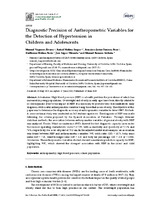Diagnostic Precision of Anthropometric Variables for the Detection of Hypertension in Children and Adolescents
Autor
Vaquero Álvarez, Manuel
Molina Luque, Rafael
Fonseca del Pozo, Francisco Javier
Molina Recio, Guillermo
López-Miranda, José
Romero Saldaña, Manuel
Editor
MDPIFecha
2020Materia
AnthropometryHigh blood pressure
School population
METS:
Mostrar el registro METSPREMIS:
Mostrar el registro PREMISMetadatos
Mostrar el registro completo del ítemResumen
Introduction: High blood pressure (HBP) is a health problem the prevalence of which has increased in young populations. Overweight and obesity in early ages have been directly related to its development. Due to the impact of HBP, it is necessary to provide tools that facilitate its early diagnosis, with useful anthropometric variables being those that assess obesity. The objective of this paper was to determine the diagnostic accuracy of anthropometric variables to detect HBP. Methods: A cross-sectional study was conducted on 265 students aged 6–16. The diagnosis of HBP was made following the criteria proposed by the Spanish Association of Pediatrics. Through different statistical methods, the association between anthropometric variables of general obesity with HBP was analyzed. Results: Waist circumference (WC) showed the best diagnostic capacity (area under the receiver operating characteristic curve = 0.729), with a sensitivity and specificity of 72.2% and 76%, respectively, for a cut-off point of 73.5 cm. In the adjusted multivariate analysis, an association was found between HBP and anthropometric variables: WC (odds ratio (OR) = 10.7), body mass index (OR = 7.5), waist-to-height ratio (OR = 5.5) and body fat percentage (OR = 5.3) (p < 0.05). Conclusions: The anthropometric variables studied showed a moderate predictive capacity for HBP, highlighting WC, which showed the strongest association with HBP in the infant and child population.

